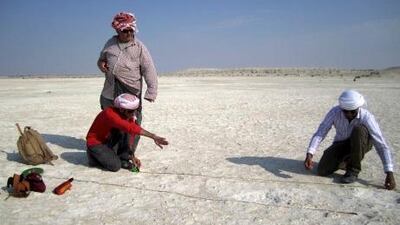Seven million years ago, a herd of elephants were crossing a muddy area in what is currently modern-day Al Gharbia. The trackway was preserved and buried for millenia. Now it has turned into a clue about the lives of the prehistoric animals, suggesting similarities in behaviour between them and their modern ancestors.
The findings were published Wednesday in Biology Letters, a journal by The Royal Society, the United Kingdom’s national academy of science.
The site, said the team of scholars from Germany, France, the United States and the UAE, is the oldest known evidence of how prehistoric elephants interacted socially. Known as Mleisa 1, this is also one of the largest trackway sites in the world, covering an area of five hectares.
“It is nice when the latest scientific discoveries from the UAE reach such a wide international audience,” said Dr Mark Beech, from the Abu Dhabi Tourism and Culture Authority and one of six co-authors of the paper.
The site had been known to local residents – who believed the footprints belonged to dinosaurs – for a long time. The trackways have been studied since 2001, but it was not until last year, when they were photographed from the air, that their significance became clear.
"We really did not realise the importance of this site before we saw the photos," said Dr Faysal Bibi, the study's primary author.
Dr Bibi, a researcher at the International Institute for Paleoprimatology and Human Paleontology in Poitiers, France, and at the Museum of Natural History in Berlin.
Photographs were taken in January 2011 by study co-author, Nathan Craig, who mounted a Canon S90 camera on a kite, taking hundreds of aerial pictures that were later digitally stitched together.
“Before he even assembled the images, we were all shocked,” Dr Bibi said. Suddenly we were able to see the whole site.”
Prior to that, it was difficult to say whether the prints belonged to one or more animals. When observed from above, some tracks suggested a change in the velocity of the animals as they were walking. This indicated they were walking together as a herd. The scientists were also able to estimate the speed at which the animals were walking and thus estimate their weight. The herd is believed to have had at least 13 animals of varying sizes, from adults to a young calf.
The team also studied a 260-metre trackway of a solitary elephant. This social structure in which males leave the herd when reaching sexual maturity and returning only to procreate, is similar to that of modern elephants.
“Basically, this is fossilised behaviour,” Dr Bibi said. “This is an absolutely unique site, a really rare opportunity in the fossil record that lets you see animal behaviour in a way you could not otherwise do with bones or teeth.”
Mleisa 1 is one of many fossil sites of the Baynunah Formation, a sequence of mostly river-deposited sands that is widely exposed in Al Gharbia. The variety of fossilised bones found there show that a variety of animals lived in the Arabian Peninsula in the late Miocene Epoch, between six and eight million years ago. The rocks and fossils indicate that a river system came across the Arabian Peninsula. The freshwater ecosystem supported a thriving African-like fauna, including the elephant ancestors.
The site is within the confines of an already existing nature reserve, dedicated to the preservation of the endangered houbara bustard.
“At the moment, it is a closed area because of the houbara breeding season,” Dr Beech said. “We hope that in future we will be able to take visitors there and share it.”
Dr Bibi said there was a need to offer more protection to other fossil sites in the area.
“Many other sites are being lost and are disappearing,” he said.
vtodorova@thenational.ae

